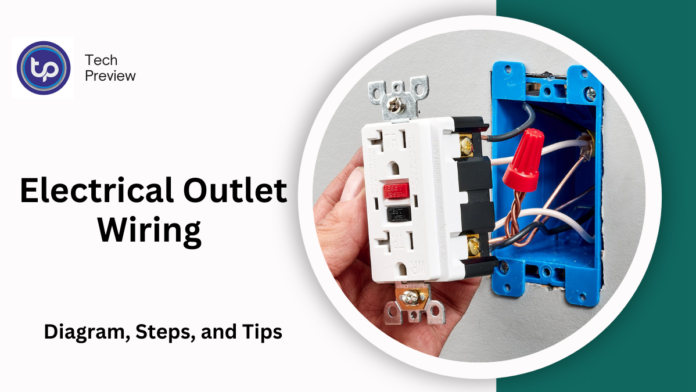Electrical outlets, often referred to as receptacles, are essential components in any electrical system.
They provide an accessible connection point for devices to draw power from the home’s electrical system. Everything from your smartphone charger to your kitchen appliances depends on a properly functioning outlet.
While there are various types of electrical outlets tailored to specific appliances and usage, all of them serve the same fundamental purpose: to supply electrical power in a safe and controlled manner.
In this article, we’ll break down the basic components of an electrical outlet, explain how to wire an outlet, and provide a general overview of outlet wiring diagrams.
Important Note: This guide is intended to help you understand how outlets work and their basic wiring structure.
It is not a how-to tutorial for installing or modifying electrical outlets. For any electrical installations or modifications, always seek the help of a licensed professional.
What is an Electrical Outlet?
An electrical outlet, or receptacle, is a connection point where you can plug in devices to receive power.
The most common type of outlet in residential settings is the 120V 15A duplex outlet, which has two slots for plugs.
Each slot corresponds to the “hot” and “neutral” connections, with the ground connection for safety.
These outlets allow electricity to flow safely to your devices, ensuring that power is supplied efficiently without the risk of overheating or short-circuiting.
There are multiple variations of electrical outlets, designed for specific purposes, such as:
- 15A 120V Outlet – Standard outlets used for regular household appliances.
- 20A 120V Outlet – Designed for more power-hungry devices.
- 30A 250V Outlet – Typically used for larger appliances such as dryers or ovens.
- GFCI (Ground Fault Circuit Interrupter) Outlet – Provides protection in areas where water exposure is possible (e.g., bathrooms, kitchens).
- AFCI (Arc Fault Circuit Interrupter) Outlet – Protects against electrical fires caused by arc faults.
Regardless of the specific type, every outlet has the same basic components for wiring: a hot wire, neutral wire, and ground wire.
MUST READ: Multi-Channel Home Theatre Systems: Unlocking Cinematic Sound at Home
Electrical Outlet Wiring Basics
Before you start wiring any electrical outlet, it’s essential to understand the key components involved in the process. At the heart of any outlet is a set of screw terminals that connect the various wires:
- Brass Terminals – These are used to connect the hot wire (typically black or red).
- Silver Terminals – Used to attach the neutral wire (usually white).
- Green Terminal – The ground wire is connected here (typically bare or green).
In addition to these screw terminals, there are two common types of wiring methods that you will use when connecting an outlet to your electrical system: direct connection and pigtail connection.
Direct vs. Pigtail Wiring
- Direct Connection: In this method, the incoming wires are connected directly to the screws of the outlet. This approach is typically used when the outlet is the last in the series of outlets, meaning no other outlets are dependent on it for power.
- Pigtail Wiring: This method involves creating a “pigtail” by joining the incoming wires with a short piece of wire, which is then attached to the outlet’s screw terminals. This method is preferred because it allows for easy disconnection of any single outlet without affecting the entire circuit.
Step-by-Step Wiring Process
- Prepare Your Wires: Before starting, strip about an inch of insulation from the ends of the three wires: hot (black), neutral (white), and ground (green or bare copper).
- Connect the Ground Wire: Loop the ground wire around the green screw terminal in a clockwise direction, ensuring a firm connection when the screw is tightened.
- Attach the Neutral Wire: Insert the exposed end of the neutral wire into the silver screw terminal. Loop it clockwise around the screw and tighten it securely.
- Connect the Hot Wire: Similarly, insert the exposed hot wire (black) into the brass screw terminal, loop it around the screw, and tighten it.
- Insert the Wires into the Box: Once all wires are connected, carefully tuck them into the electrical box. Start with the ground wire, then the neutral wire, and finally the hot wire. Make sure they are organized and not pinched.
- Mount the Outlet: After all the wires are inserted, place the outlet into the box and secure it with screws. Then, install the cover plate to complete the installation.
Important Wiring Tips
- Proper Grounding: Grounding is a critical safety feature. Ensure that the ground wire is connected to the green terminal to prevent electrical shocks.
- Using Pigtails: This method is recommended as it isolates each outlet and allows for easy disconnection without affecting other outlets on the same circuit.
- Correct Orientation: While there’s no official code for outlet orientation, many electricians recommend positioning the ground terminal at the top when installing a vertical outlet. This minimizes risks if a plug becomes partially exposed.
Conclusion
Wiring an electrical outlet is a straightforward process, but it requires a solid understanding of the components involved and the correct techniques for safe installation.
By following the correct procedures and using pigtails for wiring, you can ensure that your outlets are safe and functional.
However, if you’re not experienced with electrical work, it’s always wise to hire a licensed electrician to handle the installation.
Electricity can be dangerous if mishandled, so professional assistance is always the best option when making changes to your electrical system.
People May Ask
1. What is the difference between a GFCI and AFCI outlet?
GFCI outlets are designed to prevent electrical shocks by shutting off power when a ground fault is detected, while AFCI outlets are meant to detect and prevent electrical fires caused by arc faults in the wiring.
2. Can I install outlets myself, or should I hire an electrician?
While DIY wiring is possible, it is recommended to hire a licensed electrician, especially if you’re not familiar with electrical systems. Electrical work can be hazardous, and an expert will ensure everything is installed safely and up to code.
3. What is the purpose of a pigtail connection in outlet wiring?
A pigtail connection allows you to connect multiple wires to a single terminal. This ensures that other outlets in the circuit remain powered, even if one outlet is disconnected.
4. How do I know if my outlet is wired correctly?
If your outlet is properly wired, the hot, neutral, and ground connections will be secure, and there will be no exposed or loose wires. You can also use a simple outlet tester to check if the wiring is correct.
5. Why is grounding important in electrical outlets?
Grounding is a safety feature that helps prevent electric shock. It provides a path for electricity to flow safely to the ground in case of a fault, reducing the risk of electrical hazards.
Click here to learn more.








